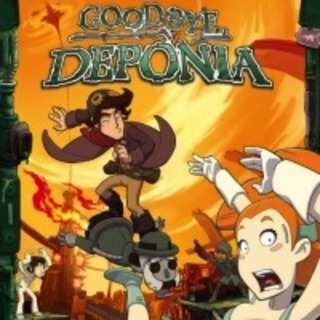INTRO:
After the heaps of trouble that the completely incorrigible Rufus has gotten himself into, one would wonder how many more fiascos which he can cause. This question is answered in the third and final entry in the Deponia series; Rufus can get himself into thrice the trouble, apparently by cloning himself. At the same time, any questions which the player may have about Rufus’s background and why certain characters resemble him are answered.
That is so, if the player can stomach some glaring problems with the game.

TUTORIAL:
The tutorials of the Deponia series are perhaps one of its most noticeable aspects when the series is compared to other adventure games. This is because of their peculiar humour; where tutorials tend to be dry (if there are any at all in a game), the Deponia series takes every chance to break the fourth wall with its own.
This time around, the person who is talking to Rufus in his “recurring nightmare” (as he would put it) is none other than Toni, his ex-girlfriend. As to be expected of someone who had to put up with Rufus for a long time, she is very irritable. Fortunately, her lines are delivered clearly enough to be concise and understandable.
Interestingly, a later chapter in the game will reveal the significance of the tutorial area. Of course, to elaborate further is to include spoilers in this review, but it should suffice to say that the tutorial area does have some contribution to the narrative of the series.
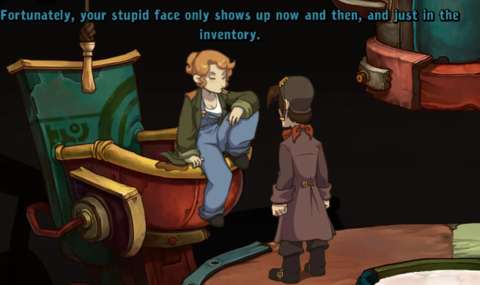
CHARACTER DESIGNS:
The following has been said many times before, but it is still true: the characters in a point-and-click adventure game are its most important aspect, at least when it comes to entertainment appeal. The Deponia series has not been a disappointment in this regard, though its most entertaining character still remains its most irritating.
Of course, that character is none other than Rufus. He still makes obnoxious remarks in addition to witty ones, and he is still very much an egotist. It so happens that in one chapter, the player is treated to three times the tomfoolery from Rufus.
However, in the final entry, he would be saying and doing nasty things that make him seem as callous as he is obnoxious. Moreover, he does not always say or do these things unwittingly, as he usually does.
There are more than a few scenes where Rufus would face reckoning for all the harm that he has done, but he, and his clones, remain terribly obstinate.
Indeed, one could say that Rufus is at his worst in Goodbye Deponia, when sanctimony has creeped into his motivations as well. When compared to the other protagonists that Daedalic has come up with, Rufus is perhaps the most difficult to sympathize and empathize with.
Fortunately, there is a saving grace of sorts for him in the story, specifically in the last few acts when he has to confront and even cooperate with equally terrible persons. Rufus will make one last act that will change, or at least put in doubt, the opinion of a player who thinks terribly of him (of whom this reviewer happens to be one).

Goal’s mind is no longer in three pieces, so her entertainment value is considerably less than it was in Chaos on Deponia. Nevertheless, she is again subjected to more kinds of harm due to Rufus’s lack of wit (and respect for life, as one other character would mention later). Yet, she remains the only person who still believes in Rufus, and will point out Rufus’s contribution to Deponia, despite all the trouble that he has caused.
This contrasts with other characters, most of whom had already given up on him or even developed unhealthy aversions towards him (namely Bozo), often for understandable reasons.
Speaking of other characters, the player will see some returning characters, some of whom were in the first entry but not the second. An example is Lotti, the ambiguously-gendered former receptionist at the town hall of (now destroyed) Kuvaq; she returns as a resistance fighter. Some of the characters from the second entry also return, though admittedly, few of them are memorable; Liebold is one such obscure example.
The other returning characters recall all too well how horrible Rufus has been. It so happens that Rufus will need their help, and they certainly won’t give it, at least not initially. For example, Rufus will need Bozo to obtain permission past a certain gate, but after a series of disasters which Rufus inflicted on Bozo, he is very much reluctant to do so. Coincidentally, convincing him invariably means adding further insult to injury.
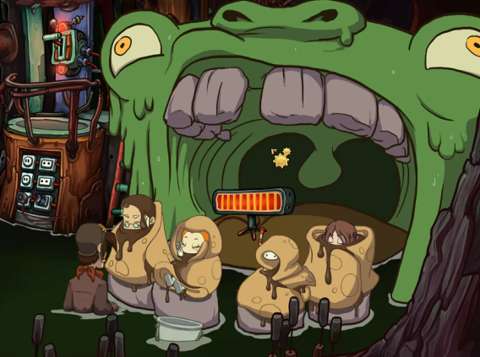
Next, there are the new characters. Goodbye Deponia one-ups Chaos on Deponia by introducing even more interesting characters, such as Bozo’s family members (which include a heavily bearded baby) and – finally – some Elysians other than Goal and Cletus. (The Organon do not count as Elysians, the reason for which will be divulged in the story for this game.)
These new characters mainly serve to demonstrate how awful Rufus has become. The most prominent of such characters are a bunch of abandoned children, whom Rufus treats poorly. These shenanigans would have been hideous if they do not happen to be amusing at the same time, though the player might need to have a sense of schadenfreude.
With the final entry, the Deponia series closes the loop on the cast of characters which an astute player would have expected from the series’ settings. Although there had been plenty of one-shot characters who did not manage a second appearance, each of them had contributed (to various degrees) to the humor of the series.
STORY-WRITING:
Rufus’s penchant for getting into trouble had not waned, so there will be no shortage of obstacles which he has to overcome (if not outright obliterate with his recklessness). Indeed, Goodbye Deponia would appear to be the longest entry in the series, with plenty of scenarios and crises tossed the player’s way, followed by exposition on many unanswered questions that also happen to double as plot twists.
If the player has a liking for roller-coaster stories, Goodbye Deponia would be quite satisfying. There are scenes where Rufus faces major setbacks, only to rebound again. The most exemplary of these is the plot twist where Rufus learns about his origin after having fallen to despair, and then returns to the fight for Deponia not as one person, but three.
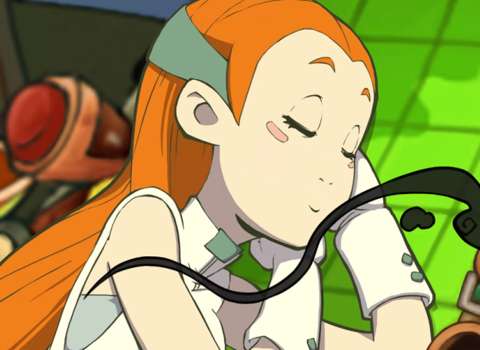
PUZZLE DESIGNS:
As to be expected of an adventure game, Goodbye Deponia has plenty of puzzles for the player to deal with. With the inclusion of three Rufus-es to manage, the puzzles have increased a bit in complexity, though not as much as one would think; this will be described later.
Many puzzles will require the player to remember what he/she has seen earlier; this is par for the course in the adventure game genre.
Yet, there are some puzzles where remembering things might not help the player, but hinder the player instead. For example, there is one puzzle which has the player giving shampoo to another character; the shampoo supposedly deters lice, according to another character. Yet, in the next phase of the puzzle, the player must infect that character with lice in order to progress, even though that character has used the shampoo.
Having known the properties of the shampoo, the player might think twice about applying the lice. Even if he/she does anyway, he/she might think that there have been some inconsistencies between the puzzle solution and the description of the item which has been used for that solution.
There are other elements in the game which contribute to the puzzle designs. They are significant enough to warrant their own sections, as will be described shortly. However, it has to be said first that they are not necessarily for the betterment of the game.
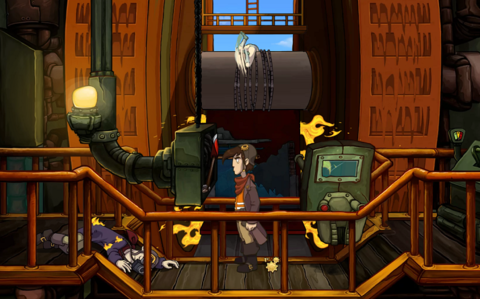
MULTIPLE RUFUS-ES:
There is a chapter in this entry of the Deponia series that has the player controlling multiple Rufus-es. Although mentioning this would have been quite a spoiler, it has to be mentioned here because the gameplay that such a premise would provide is quite significant – and also not exactly as exciting as it sounds.
The player will need to have one particular Rufus do quite a bit of legwork before the other two can make significant advances towards their own goals. Although the other two will have to do things which (deliberately or unwittingly) help that particular Rufus, that particular Rufus still does most of the job.
Even after certain points in the story when the player finally gets to have the Rufus-es share items with each other on the fly, the player will still need to focus on one Rufus and try to make as much progress as possible with him before the player is stuck. This is when the player should switch over to another Rufus and try to do as much as possible with that one until he causes a change in the circumstances of the other Rufus-es, or at least obtain something that can be tossed to the others.
Of course, it can be argued that this is better than resorting to trial-and-error and possibility-elimination when one is stuck, as is wont to happen in adventure games when the player could not fathom what to do next.
Yet, some of the aforementioned changes in circumstances can seem to be little more than deux ex machina. For example, there is one Rufus who would throw a modified paper plane at something in his vicinity, only to have the winds on Deponia alter the flight of the plane such that it lands somewhere near another Rufus, who so happen to need the plane for himself, conveniently enough.
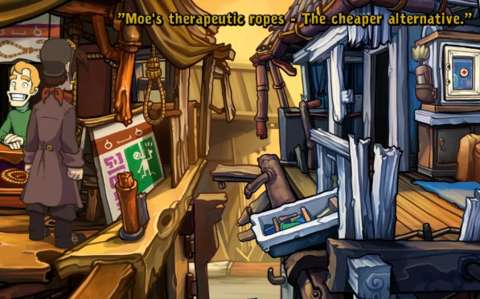
The logic behind the ability of the clones to share items is that they are passing items through sewer grates. However, this logic is quickly forgotten as the clones go to separate places. The convenience is still there, fortunately.
MOTION-CONTROL PUZZLE:
For better or worse, there is one puzzle in the game for which the player must move the mouse around in order to have Rufus mimic the movement of another character. Unfortunately, the scripts which track the movement of the mouse cursor are frustratingly finicky. Solving this puzzle is as much a matter of luck as it is determination. The player does not get to skip this puzzle.
(Side note: Speaking of skipping puzzles, it appears that there are far fewer options to skip puzzles in Goodbye Deponia than in previous games. This may not please players who are mainly playing the game for its story.)
PAUCITY OF LOGIC PUZZLES:
Goodbye Deponia has considerably less puzzles which need logic than the previous entries do. Most of the puzzles in the final entry has the player using items on other items, i.e. the usual fare in the genre that rewards processes of elimination.
This is not necessarily for the worse, of course. The logic puzzles in the Deponia series have the tendency to utilize circumstances that are seemingly only there to make them more complicated, such as broken sections in control interfaces or simply terrible and inane mechanical design in the machines which Rufus has to operate.

STORY-WRITING:
Being the final entry in the series (assuming that there will not be any more), Goodbye Deponia answers many questions that a player who has been following the series would have. Examples include the reason behind the similar appearance of certain important characters, the motivations of characters other than Rufus and Goal, and revelations about characters behind the scenes, such as Ulysses.
Yet, there are also some loose ends. Firstly, the fate of many secondary characters at the end of the game is not clear, especially those who suffered due to Rufus’s tendency to screw things up. The status of one of the main antagonists, specifically Bailiff Argus, after the finale is not clear too.

Of course, one could speculate that Daedalic is keeping some content for a possible sequel, but even if this is true, the way that Daedalic shorn off scenes and left things unexplained would not be acceptable to everyone.
VISUAL DESIGNS:
As to be expected of a Deponia title, there is quite a lot of detail to the artwork in the game, at least where static scenes are concerned.
However, there are a few oversights in the artwork. For example, the artists of the game forgot to include an updated version of Toni’s sprite when Rufus tricked her into returning to her old angry self.
To cite another oversight, there is a very important character who happens to have dark skin when he first revealed his face. However, this fact appears to have been forgotten, when he was later shown to be disguised as a certain other person whose appearance had been copied many times. In hindsight, it may be that the dark skin was an overlooked mistake on the artists’ part in the first place, considering that the aforementioned character is supposed to be genetically similar to another character, who happens to have light skin.
Animations are sparse, much like in the previous two games. Time would not make this more acceptable to every player. Furthermore, observant players might notice some recycling of animations. For example, some animations which are exhibited by Rufus are recycled for Cletus, with little variations.

The most prominent example of Daedalic’s lack of effort is the use of the same character sprites for two different persons. This will be difficult to elaborate without giving away spoilers, but it should suffice to say that one character will disguise himself as another character, and in this case, Daedalic used the latter’s sprites to express this scenario.
Granted, one could argue that these two characters are identical in many ways where the narrative of the game is considered, so the reuse of sprites should be justified. Yet, it has to be pointed out here that Rufus has disguised himself as the other character before, and not just once. At least his sprites have been altered a bit so that there are some details which differentiate him from that other character.
BUGS, GLITCHES & CRASHES:
The previous two entries in the Deponia series have technical problems, but they were not as numerous as those in Goodbye Deponia.
The sprites of characters can disappear when the player switches between the Rufus-es, or when the player reloads saved-games. Fortunately, this usually occurs after the usefulness of these characters have been expended, though their expended usefulness is not immediately clear to the player.
In the previous entries, the object/character highlighting tool is mostly reliable. It is not so in Goodbye Deponia. In many scenes, especially the later ones, icons do not appear at the correct locations, or there may be more than one icon for an object or character. Sometimes, the icons do not appear at all; the player has to move the mouse cursor over the object or character.
Even if the player can move the mouse cursor over a character or object and see icons for interactions, he/she may not always be able to interact with it, or even examine it. This can be seen in the later parts of the game too, such as an encounter with Organon troops and Bailiff Argus while Rufus is disguised.
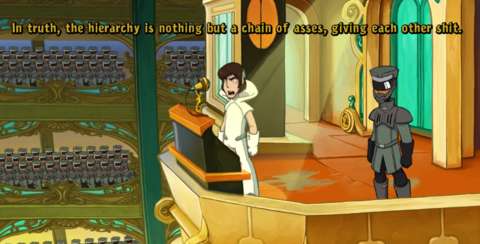
Fortunately, this glitch only occurs after the player no longer needs to do anything with the objects and characters, though, again, that the player no longer needs them may not be immediately clear.
Sometimes, certain sound effects which are not associated with a scene are not silenced when the player moves on to another scene.
For example, in one of the scenes in Porta Fisco, there is an elderly woman who is chopping unrecognizable food materials; this is accompanied by a repetitive noise akin to a knife hitting a chopping board, appropriately enough. When the player leaves that scene for an adjacent one, the noise remains. This goes on until the player switches to another Rufus.
Next, there are crashes to deal with. They can occur if the player is playing in windowed mode, usually when the player switches back to the game after temporarily leaving it to do something else. Considering that this rarely if not never happens in the previous entries, that they happen in the third entry makes them stand out more.
VOICE-OVERS & SUBTITLES:
The previous two entries in the series had characters mouthing some awful statements here and there – and typically that would usually be Rufus. However, the final entry is perhaps the most eager at doing so.
The most prominent example of this is when Rufus, who is disguised as another person, delivers a speech which is quite loaded with expletives.

A few voice-overs do not match the subtitles. For example, there is one part in the story where a character disguises himself as another character. The subtitles have the character making remarks about the shoes which he has to wear, but the voice-overs do not mention them at all.
There are also more than a few mistranslations from the original Deutsche lines to the English ones. For example, certain teleportation devices in the game are called “goods transporter” and “matter transporter” alternatingly; the latter should be the more appropriate synonym. In fact, this particular example has been in the previous entry, and nothing has been done to address this.
Guffaws like these, small as they are, still detract from the experience of the game. If not for these rough edges, the voice-acting and subtitles, at least for the English versions, would have been just as excellent as those in the previous entries.
MUSIC:
By the time of Goodbye Deponia, the soundtracks which have been used in the series would sound all too familiar to a follower of the series. There are not many new tracks to be heard in the final entry, and more than a few soundtracks which have been heard in the previous entries are used again here, sometimes more than twice.

SUMMARY:
Goodbye Deponia is supposed to be ultimate entry of the Deponia series (or at least its first season, if all that speculation about sequels is to be believed). Yet, the send-off to the series is marred by technical problems, oversights in the artwork and humor that is coarser than is comfortable. Still, if the player can forgive all these problems, there is a (mostly) satisfying finale to be had, which includes a memorable redemption for the walking incarnate of calamity that is Rufus.
